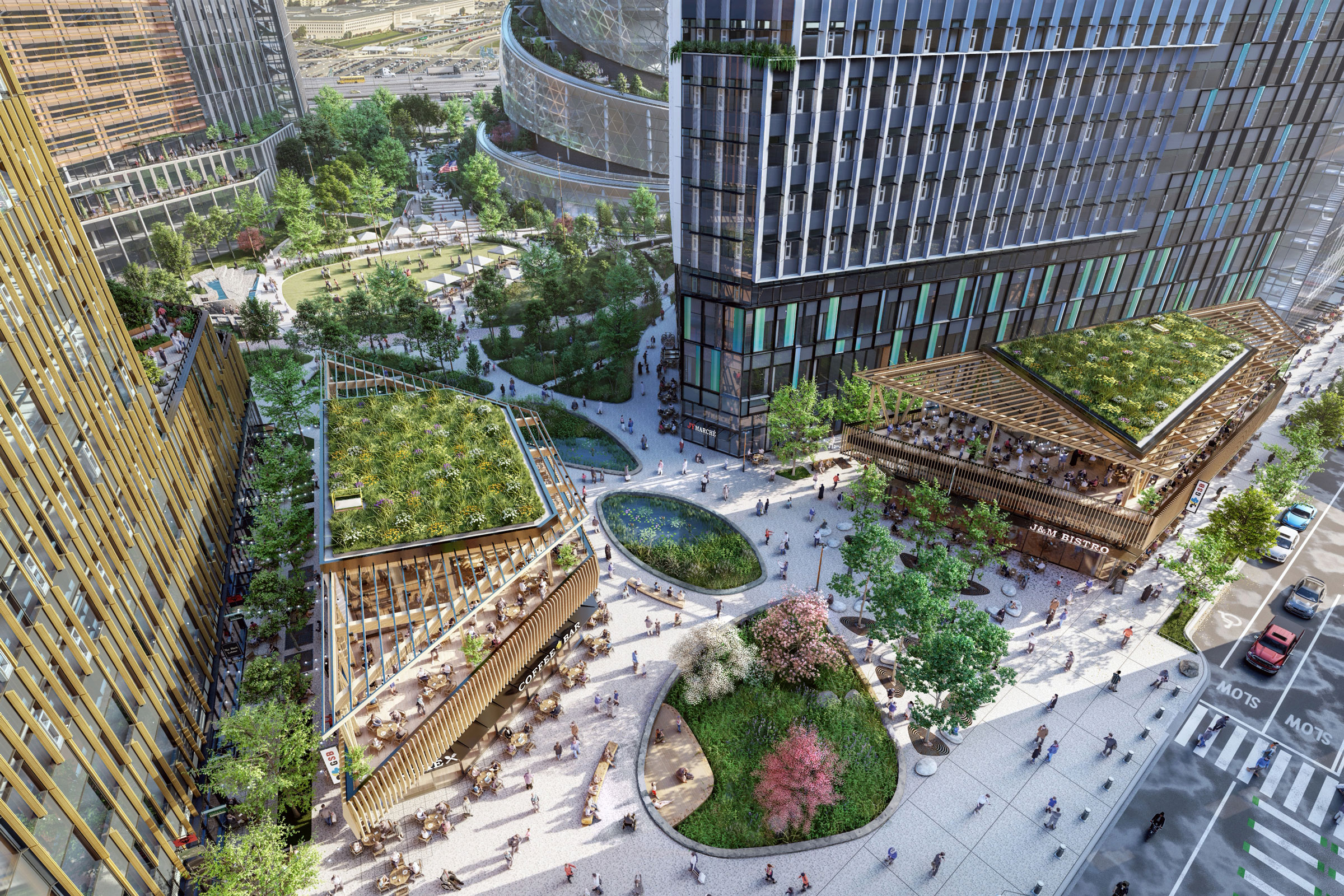Story at a glance:
Targeting LEED Platinum and clocking in at a total of 2.8 million square feet, Amazon’s future East Coast headquarters is not only big, it has some very ambitious sustainability goals. The first phase of HQ2—Metropolitan Park, including two LEED office buildings and 2.5 acres of public park—is expected to open in 2023. The second phase of HQ2, PenPlace, will begin to deliver in 2026.
While it’s quite literally massive, it’s just one in a long list of projects that emphasizes healthy design—from sustainable building materials to green space to proper acoustics—as people reconsider what it means to work in today’s office buildings.
Beyond health, there’s a compelling business case for building green, according to the USGBC. The average reduction in operating costs for the first 12 months in a new green building is 10.5%, and five-year cost savings are 16%. Green renovations and retrofits have even greater performance globally at 11.5% and 17% respectively. Owners also report that new and retrofit green building projects see an increase in asset value by more than 9%.
We explore some of the key aspects of building green, whether it’s a multimillion dollar project like Amazon or your office building next door.
Sustainable Building Materials
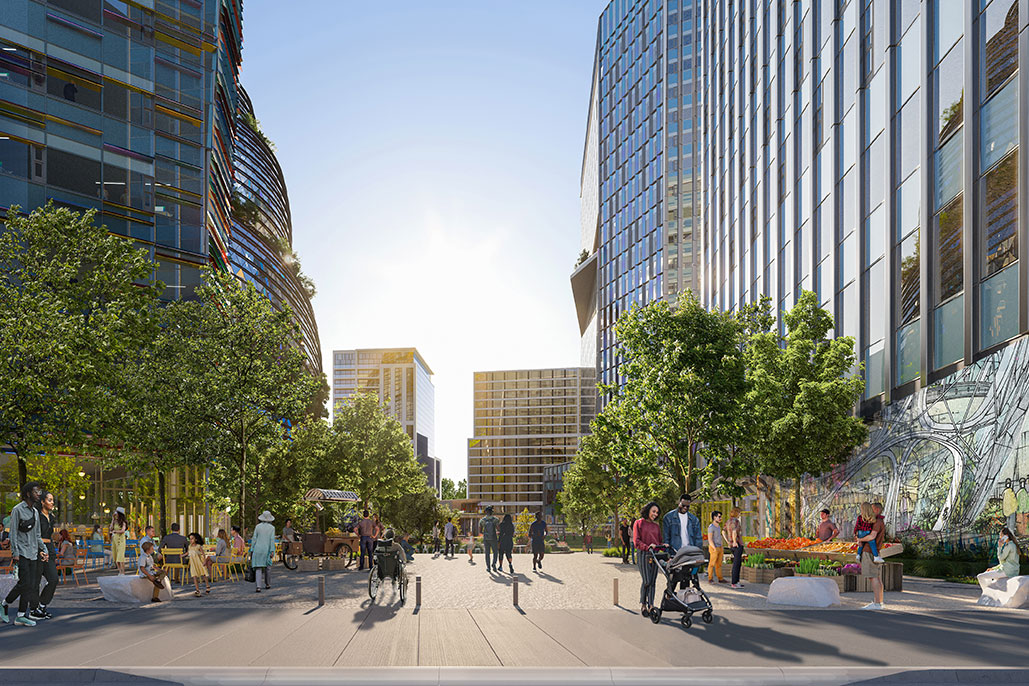
Photo courtesy of Amazon
Windows, solar, heat pumps, toilets, stormwater management, and lighting are among the many areas where improvements can and are being made, according to the USGBC.
At Amazon, the HQ2 project will have electrified operations—eliminating fossil fuels for buildings systems and food service. They’ve also committed to powering 100% of the headquarters’ operations with renewable energy through a combination of off-site and rooftop solar projects. They have reduced the amount of embodied carbon in the concrete structure compared to typical construction practices by at least 10% and are committed to offset 100% of the remaining embodied carbon from building materials.
“The project also includes dark sky compliant lighting design and a high-performance facade with external shading tuned by the project’s orientation, as well as chilled water thermal energy storage that consists of over 1 million gallons of water storage, which can reduce peak electrical demand by over 1 MW,” says Dale Alberda, principal architect at NBBJ Design, the architecture firm designing the PenPlace project, including the Helix—an elaborately designed variety of alternative work environments amidst lush gardens and native trees native, with landscapes designed by Scape.
A rainwater and stormwater harvesting system will also capture HVAC condensate and utilize dewatering water to serve non-potable uses throughout the campus. Amazon is working toward its own climate pledge to be net-zero carbon across operations by 2040.
“We strive to specify more sustainable and environmentally friendly materials whenever possible in the project. For example, bird-safe strategies, including bird safe glass, will set a new model for bird-friendly environments,” says Gina Klem, sustainability director of global real estate and facilities at Amazon. “In addition, embodied carbon reduction is a critical part of our material selection. Project materials were selected that have low embodied carbon emissions as verified through EPDs, to support a lower total carbon footprint of the project.” She says materials containing low to no VOCs were selected in support of improved indoor environmental quality.
Importance of Green Space
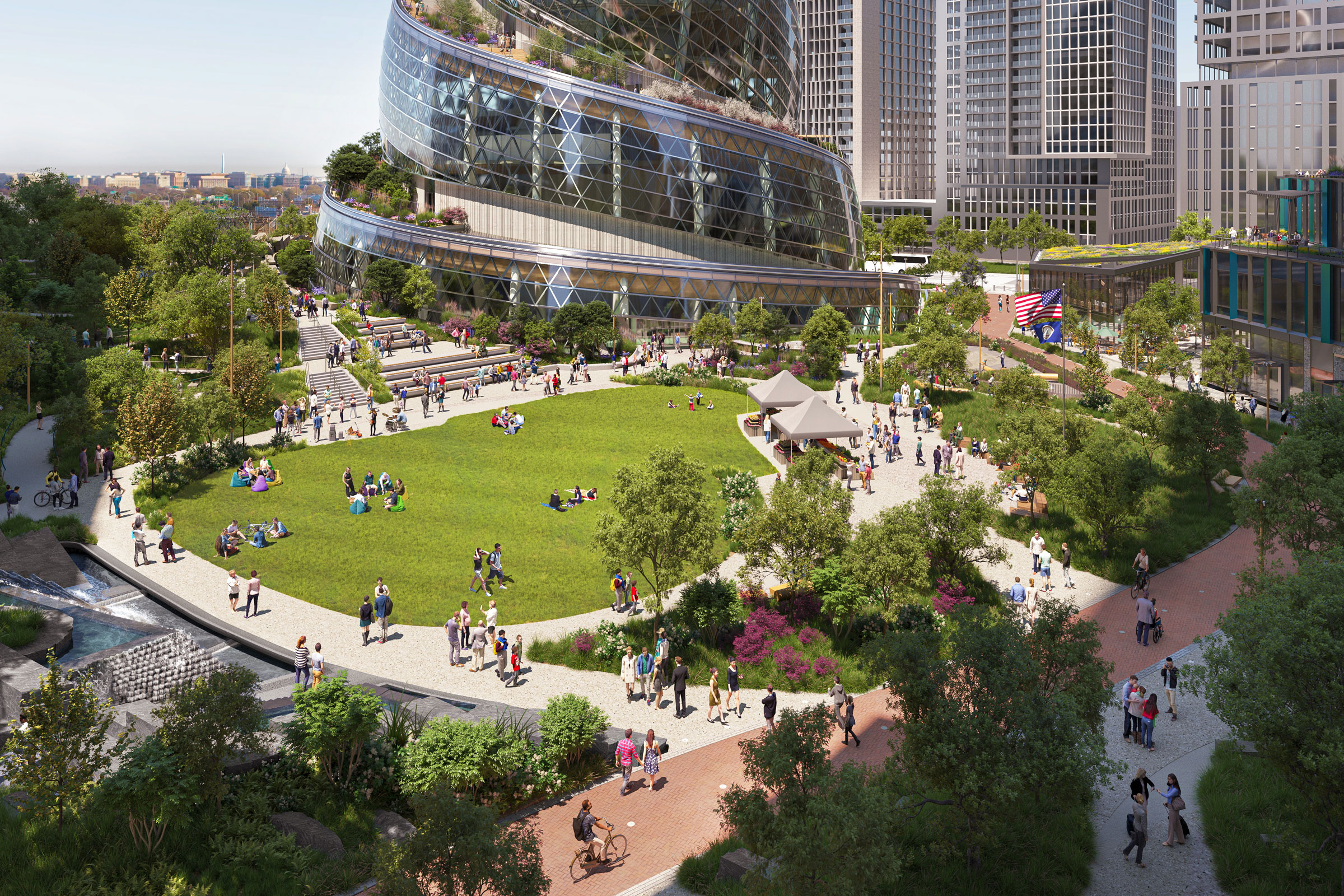
The new Amazon headquarters will include plentiful green space around the Helix. Photo courtesy of Amazon
USGBC defines green space as land that is partly or completely covered with trees, shrubs, grass, or other vegetation. This includes urban parks, trails, and community gardens—including rooftop or vertical gardens. It does not include schoolyards, playgrounds, public seating areas, public plazas, or vacant lots.
Part of Amazon’s design strategy is not only to engage the community with public spaces but also to incorporate nature with a landscape that reflects the surrounding region and offers visual interest in all seasons.
“Neuroscience research also illuminates how our environment affects productivity and creativity,” Alberda says. “For instance, 30 minutes of exercise, a moderate walk at 1.8 miles an hour, can increase executive function and reduce stress, which is further enhanced in nature.”
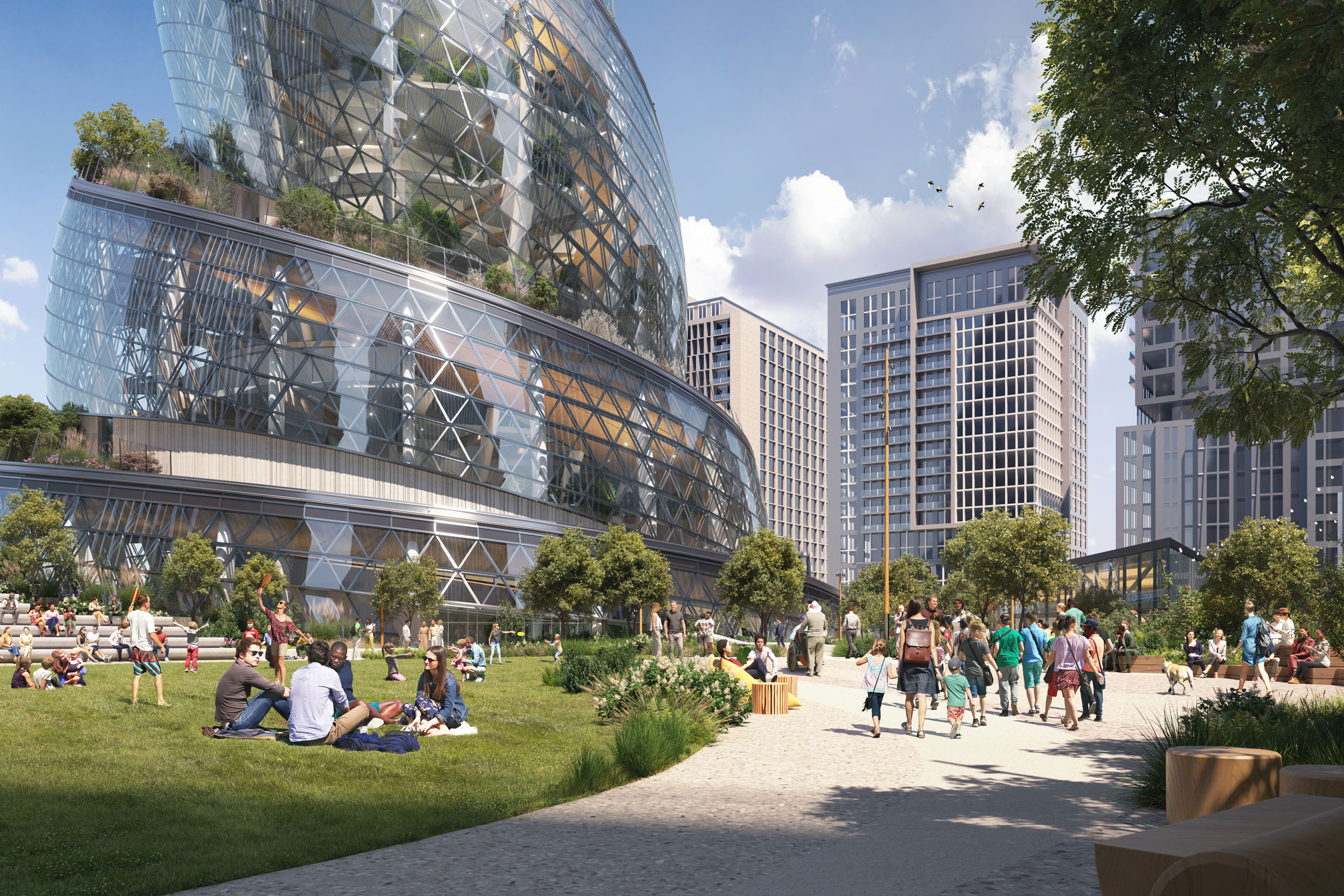
Photo courtesy of Amazon
The PenPlace project provides many chances to boost productivity and creativity through movement—from the Helix’s hill climb to outdoor pedestrian paths through 2.5-plus acres of public open green space.
“Our design philosophy is rooted in the belief that the communities in which we invest should shape us, not the other way around,” says Joe Chapman, director of global real estate and facilities at Amazon. “Our goal is to integrate into the fabric of the community by designing a second headquarters that invites our neighbors in and creates an 18-hour district that people see as a destination. We believe that our inclusion of public open green space, a forest walk, pollinator gardens, plazas to host farmer’s markets and evening movie screenings, the creation of a permanent home for Arlington Community High School, and street-level retail locations that prioritize small, local businesses, will do just that.”
The paths around Amazon are designed to encourage movement and serendipitous connections for the entire community and Amazon employees alike. The public access points will also prioritize walking, biking, and retail rather than cars, providing improved connections to nature and greater access to retail. A Forest Plaza design will also provide a chance to immerse in nature with shaded areas, while it also acts as both a visual and acoustical screen for the site from vehicular traffic.
Acoustic Products
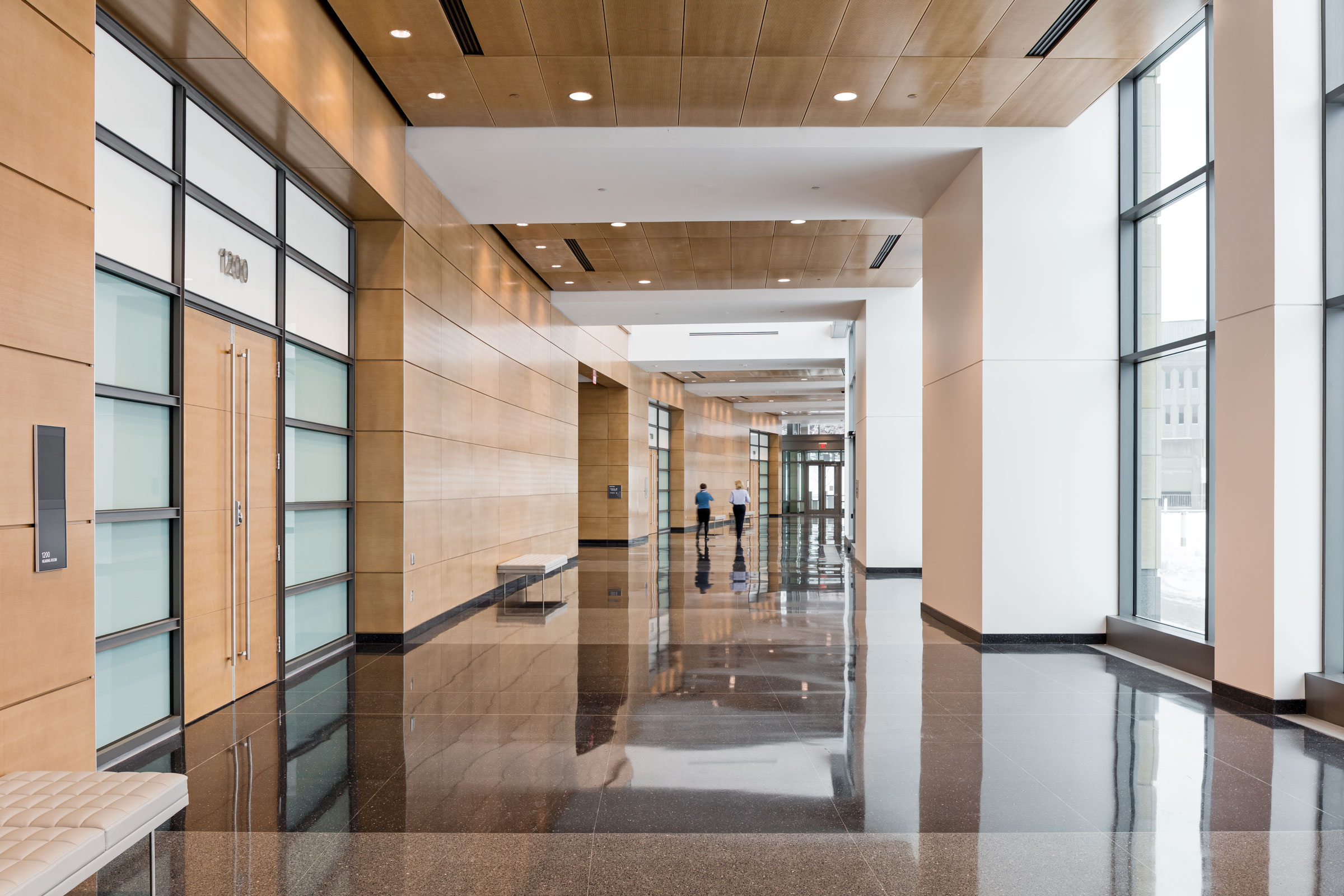
Audition acoustical wood panels and planks feature a wood veneer face and are available for ceiling and wall systems. Photo courtesy of ASI Architectural
Speaking of acoustics, the best projects consider sound from the start, according to ASI Architectural. It’s reported that 70% of global employees say office noise hurts them during the workday.
ASI recently helped one company who was having a hard time even meeting in their conference room. Though elegant, its glass walls and terrazzo floor made it difficult to hear.
“From the acoustics side they felt like they were in a fishbowl,” says Chris Blanchard, national sales manager for ASI Architectural. “The original design had one traditional wall assembly with drywall and three glass walls with a glass door. We ended up covering the gyp board wall and the ceiling with an acoustical wood product. It helped from the acoustic side but also from the design side. We couldn’t eliminate the glass wall structurally, but it warmed up the space so it didn’t feel like they were in this white, clinical fishbowl atmosphere. They had the warmth of the wood as well as the acoustical performance that went with it.”
The team used Audition to give the renovated space a monolithic linear appearance with tongue-and-groove planks that allow for easy field cutting and were simple to install using the provided clips.
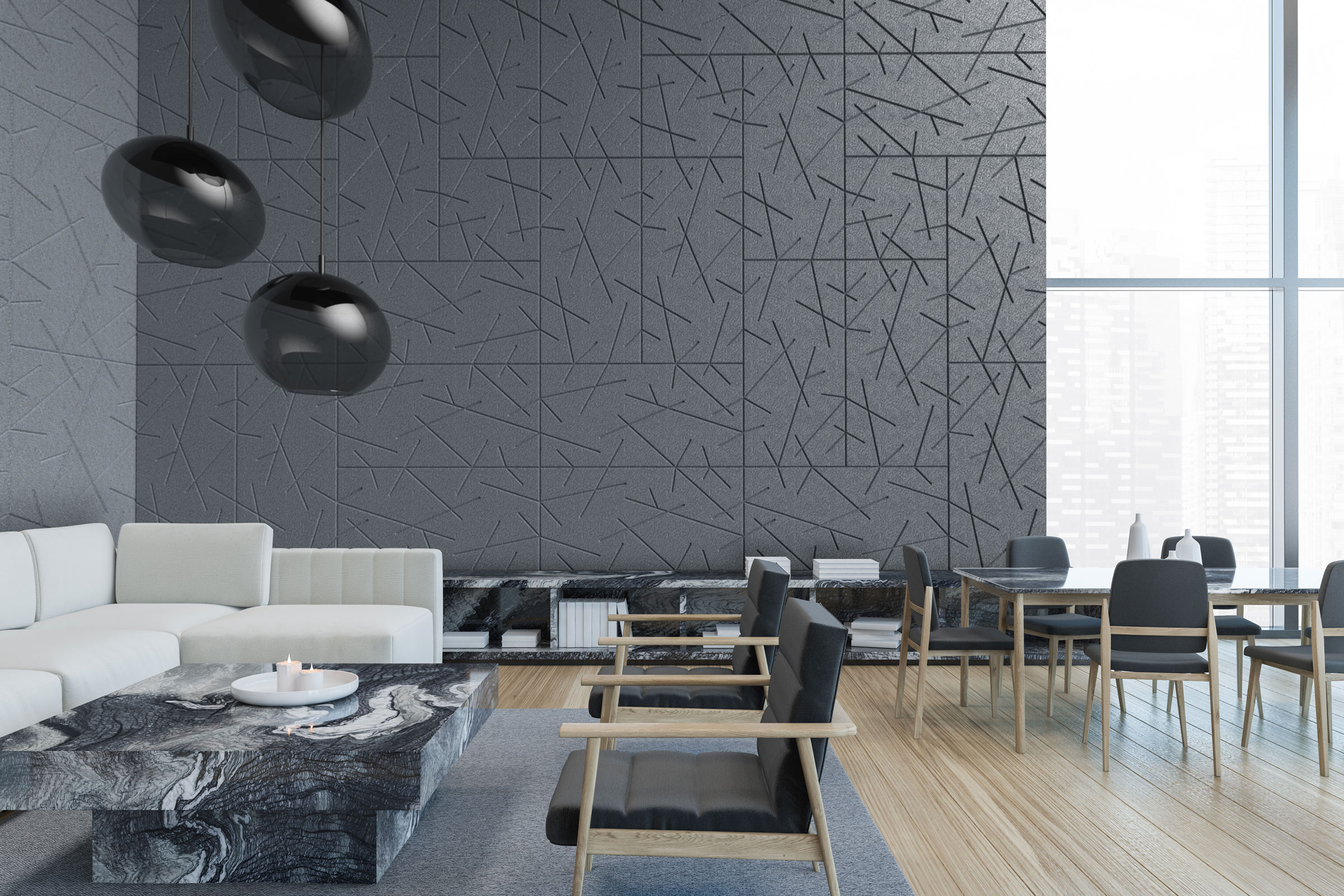
StrandTec (wood fiber) performs by absorbing sound while thermally insulating. Photo courtesy of ASI Architectural
Wood-based products like StrandTec from ASI Architectural and Envirocoustic Wood Wool from Acoustical Surfaces combine biophilia with top-notch acoustic design. StrandTec is essentially strips of wood fibers mixed with Portland cement. It’s also fire-resistant, uses mechanical fasteners, and is an economical alternative to fiberglass, foam, polystyrene, and rock wool. “That product does really well in more of an industrial setting or a high humidity setting, but its design versatility lends its aesthetics to many spaces,” Blanchard says.
“Wood Wool is also one of the only panels you can paint and get really creative with,” says Ted Weidman, commercial brand manager for Acoustical Surfaces. “Spray-applied paint doesn’t bridge and clog the porous face of the panel. We have a paint line, and we have all kinds of custom capabilities for surface patterns. If you’re looking for some fun colors and shapes to put into a space to give it a little bit of a pop, it’s a really cool option for that because it can be painted without losing its absorption characteristics.”
StrandTec and Envirocoustic Wood Wool are also available in several thicknesses, so they can be CNC-cut into any shape. The design team can vary the shape, thickness, and color to come up with virtually any design a team can dream of.
Perhaps their best solution for open offices is Microperf. “That’s a perforated wood panel that has an acoustical absorber built into the core. You can simply hang those wood panels on Z bars and Z clips; they have a hidden fastener that will hang right over drywall. You don’t have to add an acoustical absorber behind the wood panel.”
Blanchard says Microperf is often a great retrofit solution because it can simply be hung on the wall or attached to an existing ceiling grid.
Whether in a conference room, open office, huddle room, or private pod, sound is a critical part of design. “Depending on what the office setting is like, I would say acoustics should always be a consideration,” Blanchard says. “You know that space is always going to be full of people, and they’re always going to be talking. You’re always going to have echo and reverberation—and that’s really what we’re talking about more than anything.
What gives these products the sound absorption is a recycled cotton material. ASI takes scraps from textile manufacturing to make a natural cotton core backer.
Design for Sound
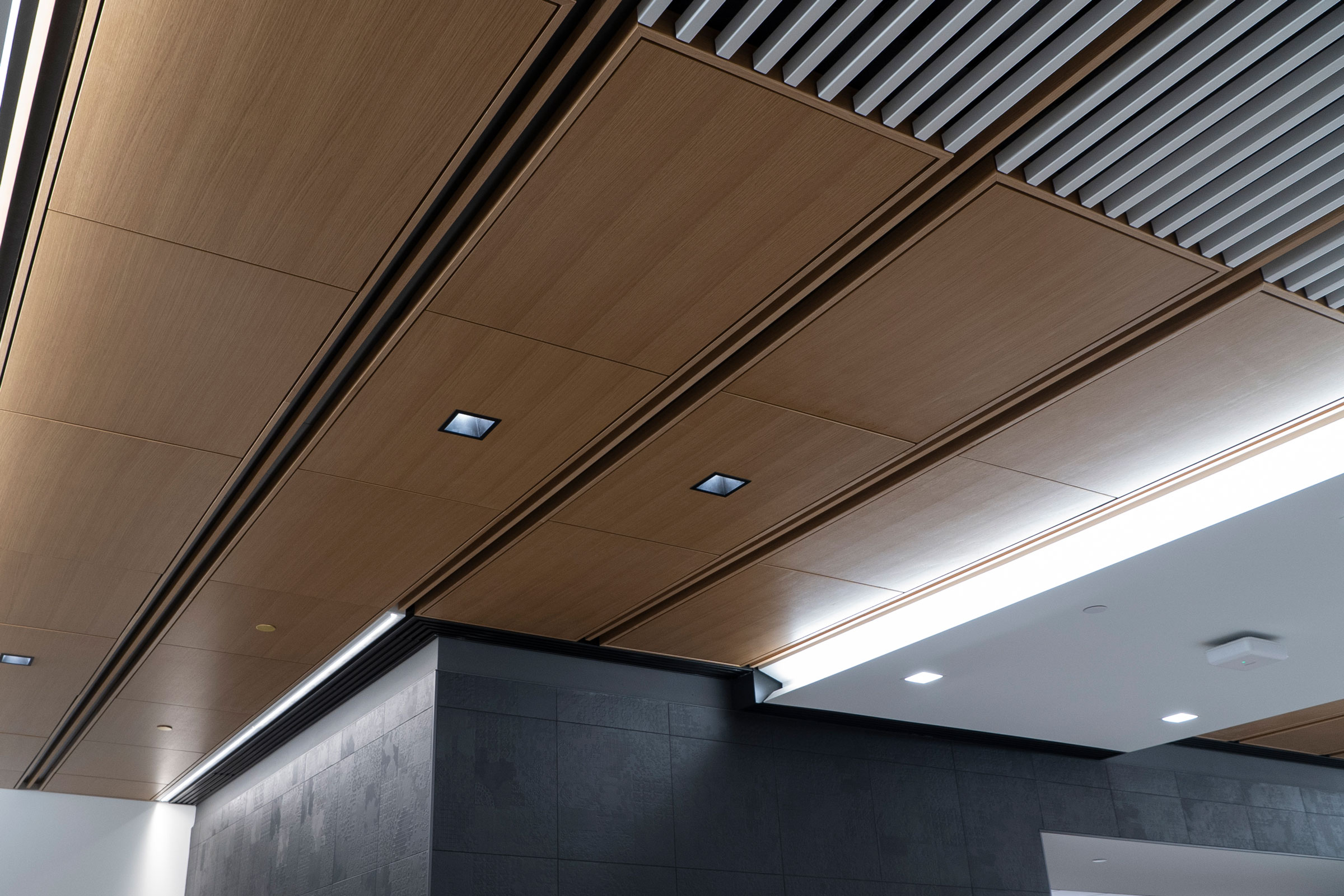
Microperf ceiling and wall panels use cutting-edge acoustical technology, enabling sound mitigation without the look or feel of typical absorber panels. Photo courtesy of ASI Architectural
Blanchard says often a designer will want to simply put an acoustic wood wall product in one place—behind a reception desk, for example. “That area is 6 feet by 4 feet. Because it’s an acoustical product the assumption is that they’ve now covered acoustics for the entire reception area. At the end of the day, there simply isn’t enough of the product for the space to make a difference you can hear with your ears. Our wall and ceiling products are true systems to treat entire open areas like large foyers and high traffic hallways.”
In an office space, he says you should be able to walk into a room and know it’s either really lively and going to drive you crazy or that it’s been treated and you can focus on your work. “Essentially you don’t even want to notice it. If no one ever complains about it, we’re winning.”
He says the biggest misconception he sees from designers is when they install an acoustic product without considering the amount of product versus the cubic volume of the space. Weidman uses a simple math problem for this—the cubic volume of the room (height times width times depth) times 4%. “Generally speaking that really simple equation will spit out a target square footage that, for most cases, is going to be appropriate to make the space more comfortable.”
Conference rooms and small spaces with all hard surfaces are often the most problematic areas to treat. “I’ve had a few people want to put glass walls and fully glass doors in to make it feel open,” Weidman says.
That’s a problem for STC, or sound transmission. “If I need to have confidential VP level conversations in this room, that is difficult to deal with when not worked into the design phase,” Weidman says. “If I take a room with a glass door that’s not sealed when it’s closed and fill that room with water, how is the water going to get out? The physics of sound are the same. Trying to seal this beautifully designed glass wall partition so it’s airtight when it’s closed is really tough without swapping out the door, the HVAC, and taking a look at the ceiling.”
He says absorbing the echo in a room like that is relatively easy and straightforward—when designed for from the very beginning. “It’s tricky once it’s built and being used, but that’s what we are here for. We solve your noise problems.”

